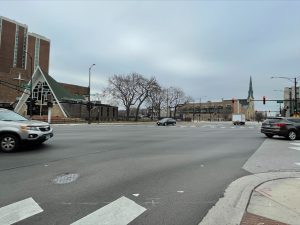May 12, 2009 – Advocates for the disabled say the CTA needs to step up its commitment to making its bus and rail stations accessible in the wake of a three-month investigation by ChicagoTalks.
“The CTA has to continue working on these issues to make the whole system user friendly,” said Jim Watkins, co-chairman of the Regional Transportation Authority’s ADA Advisory Board and a frequent CTA customer. “Are they? Yes, they are… slowly, and it’s by lawsuits quite often.”
Over a two-week period in late February, a team of reporters from Columbia College Chicago documented broken doors, turnstiles and elevators at 16 stations; another 20 lacked automatic doors that disabled advocates say make an entrance fully accessible. In all, 41 percent of the stations that are supposed to be 100 percent accessible were not.
And at several stations, broken doors remained unfixed weeks later when the team returned for second and third visits. Although the Americans with Disabilities Act doesn’t require automatic doors, the chairman of the CTA’s ADA Advisory Committee says a train stop isn’t fully accessible without them because they allow people in wheelchairs to enter and leave a station without assistance.
The CTA declined to comment on the findings or answer other questions about the accessibility of the nation’s second-largest mass transit system.
Problems discovered beginning in mid-February continued for weeks at a number of stations:
• The Ashland and Polk stops on the Pink Line; the Jefferson Park, Harlem and Rosemont stops on the Blue Line; the Addison, Granville and Loyola stops on the Red Line; the Cicero, 35th, Ashland, Indiana and 51st on the Green Line and all seven stops on the Orange Line did not have automatic doors, forcing customers using wheelchairs or not strong enough to open doors to rely on others to get in and out of the 20 stations.
• The automatic doors at six Pink Line stops – Damen, California, Central Park, Pulaski, Kostner and 54th/Cermak – didn’t work in late February, nor were they working two weeks later in March and again in early April.
• On the Red Line, the automatic doors at three stops – Garfield, 79th and 87th – were out of order along with the Rockwell and Diversey stops on the Brown Line. When those stops were checked six weeks later, the doors worked.
• Besides broken doors, elevators at Montrose on the Brown Line, Harlem on the Blue Line and the Midway/Skybridge on the Orange Line weren’t working in February and two weeks later in March, but they were fixed by the third visit in early April. The handicap gate/turnstiles at the Blue Line’s O’Hare station and the Red Line’s 35th/Sox stop weren’t working either, though they were fixed by the third visit in April.
Some of the problems found in late February appeared to have started weeks, if not months before.
At the July 28, 2008, meeting of the CTA’s ADA Advisory Committee, Watkins reported the Damen and California stops on the Pink Line had only one gap filler – which is needed to get wheelchair riders on and off the train – and that someone had apparently stolen the push button on the automatic door leading into the Damen entrance.
Watkins said he had reported these issues for the past year with no response from the CTA, according to minutes from that meeting.
In March 2008, an unidentified customer filed a complaint with the CTA about the handicapped door that connects the James R. Thompson Center to the Blue Line at the Clark & Lake stop – the busiest of the 144 “L” stations – didn’t work.
The customer complained that the door has not worked for more than a month and he had earlier sent an e-mail and tried to call the CTA, getting no response. “I think those doors should be fixed. How difficult is it to get some experts that fix doors?”
Kevin Irvine, chairman of the CTA’s ADA Advisory Committee and senior advocate for Equip for Equality, said the problems documented at 36 of the 88 handicap-accessible stations are unacceptable.
Irvine said there are two definitions of “accessible”- what is “ADA accessible,” or required under federal law, and what is acceptable by his standards.
Watkins, who relies on a motorized wheelchair, knows firsthand the problems disabled customers routinely face on the CTA. He said he frequently has problems with broken automatic doors and too often encounters disinterested employees who are supposed to help disabled riders.
That’s what appeared to happen in September 2005. A customer called to complain about being stuck in an elevator at the Green Line’s 63rd stop with five other people for 45 minutes to an hour. The unidentified customer said employees failed to ask if anyone was OK or call for help. The group finally got out of the elevator after a customer passing by heard their cries for help and notified police.
Watkins says it’s imperative that advocacy groups push for the CTA to improve its accessibility, especially as the disabled population – now estimated to number about 600,000 people locally – grows.
“People have to stay involved. If the pressure isn’t kept up, things go back to where they were,” he said. “And if there are problems you need to report them.”
Kaitlyn McAvoy contributed to this report.
Contact Elizabeth Czupta at eczupta27@aol.com.
Check out the rest of the CTA investigation:
Investigation Finds Handicapped Accessibility Issues Plague CTA by Zach Wilmes
Complaints Against CTA Keep Climbing by Danielle Desjardins and Kaitlyn McAvoy
Injury and Equipment Breakdowns Continue to Trouble Some Disabled CTA Riders by Kirsten Steinbeck
Disabled Riders Experience Years of Inconsistency in CTA Service by Danielle Desjardins
Advisory Group Works to Improve Access for Disabled CTA Riders by Kirsten Steinbeck
ChicagoTalks Video: CTA Improves But Some Disabled Still Complain by Elizabeth Czupta
INVESTIGATION: Disabled And Downtown On The CTA by Eli Kaberon
INVESTIGATION: The Inaccessible CTA by Kaitlyn McAvoy











Be First to Comment